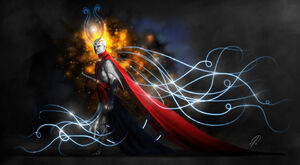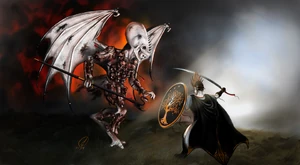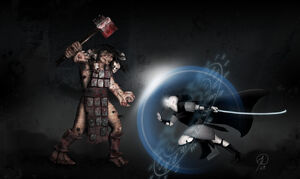
Cû’jara-Cinmoi, greatest of the Nonman kings.
The Nonmen (in their own tongue, Cûnuroi) are an immortal non-human species native to Eärwa, whose presence preceded the arrival of Men by tens of thousands of years. They achieved a tremendous level of civilisation before the Arkfall, the arrival of the Incû-Holoinas and the vile Inchoroi it carried within it. The Nonmen triumphed over the Inchoroi over the course of millennia of battle, but were so weakened by the conflict and resulting cataclysms that they were unable to prevent the arrival of men in Eärwa, who subsequently supplanted them. Today, Nonmen are only found in numbers in Ishterebinth, their sole surviving stronghold. All Nonmen females were killed thousands of years ago in the Womb Plague, leaving only males. The passage of millennia has driven many of the Nonmen insane; these madmen are known as the Erratic.
Mythology[]
According to myth, Imimorûl was the first Nonman. He fled from the Heavens into the depths under the world in a way of avoiding the gaze of the gods. In the most common scripture, Imimorûl founded Siöl as the first of the High Mansions and beget at least two children, Tsonos and Olissis. After his death, Tsonos followed his father as High King of the Nonmen. However, Nihrimsul was founded by other Nonmen from outside this tradition and rejected Siöl's authority, leading to millennia of strife and occasional war. All of the other High Mansions were founded by Siöl and by descendants of Tsonos. The Nihrimsuli, sometimes called "Dark Nonmen", were disregarded for their lack of noble blood until Sin’niroiha of Nihrimsul married Tsinirû of Ishoriöl; their son Nil’giccas was accounted of the blood of Tsonos, thus reuniting the bloodlines.
According to the Nihrimsûli, their Mansion was actually founded by Imimorûl directly. Tsonos and Olissis murdered their father whilst he slept and then fled like cowards to found Siöl. Unsurprisingly, this version is thoroughly rejected in the dominant Tsonic tradition.
Imimorûl is named as the “Father of the False” in The Chronicle of the Tusk, and in Mannish traditions, was a once-glorious God imprisoned deep in the earth as punishment for teaching sorcery to the Nonmen. According to Cûnuroi traditions, Imimorûl was not imprisoned within the earth, but sought refuge in the “Deepest Deep,” those places the gods could not judge because they could not see. Though Ajencis famously attributes the Nonman aversion to open sky to his theory of “vital accommodations,” the Nonmen themselves see this predilection as a sacred observance of Imimorûl’s ancient straits—as well as the best way to find oblivion upon their deaths.
Nonmen occasionally practice a ritual trip to the deepest part of the world they can find, known as a Fathoming. The Fathoming constitutes a symbolic re-enactment of Imimorûl’s flight from the Heavens (or “Starving”) into the depths beneath what became Siol, the House Primordial, the idea being that souls so deep can slip the notice of the Gods and find oblivion. Fathomings were most common undertaken by those upon the threshold of death, the thought being that the Deepest Deep lay on the edge of Oblivion.
The Psalms of Imimorûl seem to allege that Imimorûl had no wife but instead created the rest of the Nonman species by implanting his flesh within that of lions:
The World to him, who sings my song,
for I am the Font, the Spirit of the Deepest Deep,
and mine is the first heart to beat your blood.
The World to him, who sings my song.
I, Imimorul, fled the Heavens,
so much did I love
the brooks that chirrup,
the high mountains that hiss,
the myriads that bolt through this blessed hair,
The World to him, who raises up
rooves in the Deep.
I, Imimorul, did flee the Starving [sky],
so much did I fear the Heavens,
the wrath of those who were wroth,
who would forbid my love,
of the myriads of the World.
The World to her, who kindles her fire in the Deep.
I, Imimorul, did cut from my hand my fingers,
and from my arm, my hand,
and from my body, my arm,
and these pieces of me I did place
in the wombs of Lions,
so that I might dwell content in my own company.
And I became One-Armed, Imimorul, the Unshielded.
And you were as children to me, the form of Gods as the issue of Lions,
sons who would father nations, and
daughters who would mother the
myriads of the World.
And I sang to you such songs
as are only heard in the highest of Heavens,
and nowhere in the Hells.
We did weep together, as we sang,
for woe cares not for names or glory
only that skin blackens for bruising,
breaks for blood.
The World to him, who sings my song. The World to him, who finds me in the Deep. The World to him, and woe.[1]
History[]
The Nonmen call themselves ji’cûnû roi, “the People of Dawn,” for reasons they can no longer remember. (They call Men j’ala roi, “the People of Summer,” because they burn so hot and pass so quickly.) The Chronicle of the Tusk, which records the coming of Men to Eärwa, generally refers to Nonmen as Oserukki, the “Not Us.” In the Book of Tribes, the Prophet Angeshraël alternately refers to them as “the Accursed Ones” and “the sodomite Kings of Eärwa,” and he incites the Four Nations of Men to embark on a holy war of extermination. Even after four millennia, this xenocidal mission remains part of the Inrithi canon. According to the Tusk, the Nonmen are anathema:
- Hearken, for this the God has said,
- “These False Men offend Me;
- blot out all mark of their Passing.”
Accomplishments[]
But Cûnuroi civilization was ancient even before these words were carved into the Tusk. While the Halaroi, Men, wandered the world dressed in skins and wielding weapons of stone, the Cûnuroi had invented writing and mathematics, astrology and geometry, sorcery and philosophy. They dredged mountains hollow for the galleries of their High Mansions. They traded and warred with one another. They subdued all Eärwa, enslaving the Emwama, the soft-hearted Men who dwelt in Eärwa in those early days.
Decline[]

At the fields of Pir Pahal, Cû’jara-Cinmoi, greatest of the Nonman Kings, confronts the fierce Inchoroi King Sil, armored in festering bodies.
Their decline is the result of three different catastrophic events. The first, and most significant, was the so-called Womb Plague. In the hope of achieving immortality, the Nonmen (specifically, the great Cû’jara-Cinmoi) allowed the Inchoroi to live among them as their physicians. The Nonmen did in fact attain immortality, and the Inchoroi, claiming their work done, retired back to the Incû-Holoinas. The plague struck shortly after, almost killing males and uniformly killing all females. The Nonmen call this tragic event the Nasamorgas, the “Death of Birth.”
Cûno-Inchoroi Wars and Near-Extinction[]

A sorcerous Nonman battling a hideous Bashrag.
The following Cûno-Inchoroi Wars further sapped their strength, so that by the time the first Tribes of Men invaded, the Nonmen had not the numbers or, some say, the will to resist their advance. Within the course of a few generations they were nearly exterminated. Only the Mansions of Ishoriöl and Cil-Aujas survived.[2]
Interbreeding[]
It is possible for Nonmen to impregnate human women; and, when Nonmen females still existed, it was possible for them to be impregnated by human men. However, such mixed-breed pregnancies are rare, and it is even rarer for them to come to term.[3] Those who do survive may have very long lives; Anasûrimbor Nanor-Ukkerja I’s life of 178 years was credited to the Nonman blood in his veins.[4] The earliest known instance of interbreeding between humans and Nonmen was Cimoira, the child of the human Sirwitta and a female Nonman, whose birth was recorded in the Isûphiryas.[5]
Mansions[]
Instead of cities and castles Nonmen built underground systems of vast halls and passages called "Mansions", always located beneath the mountains. The total number of Nonmen mansions is unknown, although it is known that the mightiest, the High Mansions, numbered nine.
Greatest, most powerful and most populous was Siöl, lying under the titanic peaks of the Northern Kayarsus. The proudest and most fiercely independent was Nihrimsul, located under the south-eastern Yimaleti Mountains. Cil-Aujas lay in the east, under the peak of Aenaratiol at the south tip of the Osthwai Mountains. Ishoriöl, the Exalted Hall, lay in the far west, beyond the Demua Mountains near the shores of the Great Ocean. Viri, in the north, lay under the peak of Antareg in the Urokkas, a small range of mountains overlooking the Neleöst, the Misty Sea. Illisserû lay far to the south, under the Betmulla Mountains. Curunq lay under the Araxes Mountains and Cil-Aumûl under the Hinayati Mountains. The last, Incissal, lay under the hills near what is now the city of Domyot.
Physiology[]
Nonmen are bigger and stronger than humans. They are adapted to subterranean life and thus have skin devoid of any pigment, all-black eyes, and are hairless.
It is mentioned in the books that Nonmen cannot derive meaning from paintings, which is why they depict their history through sculpture. This may imply that they do not see colors, having monochrome vision.
The god-alien 'Engineers' in the movie "Prometheus" (2012) by Ridley Scott look almost exactly like Bakker's Nonmen.
